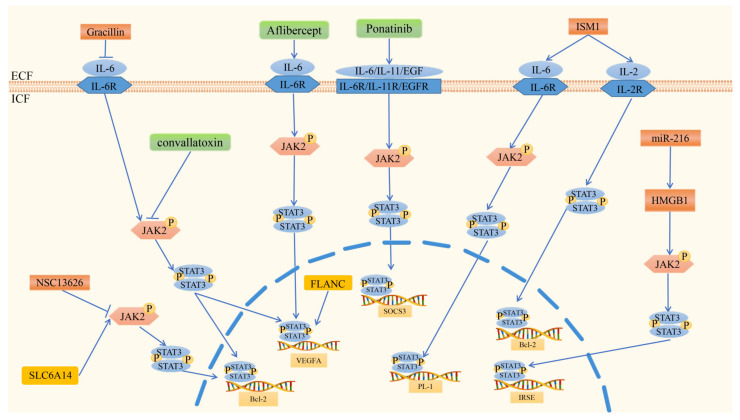Figure 3.
Regulation of angiogenesis via the JAK2/STAT3 signaling pathway in CRC. In the JAK2/STAT3 signaling pathway, SLC6A14 and FLANC promote angiogenesis. SLC6A14 activates JAK2 through phosphorylation, after which STAT3 is activated by mutual phosphorylation, and STAT3 then enters the nucleus and activates the transcription of Bcl-2. FLANC enters the nucleus directly and activates the transcription of VEGFA. Factors inhibiting CRC angiogenesis via JAK2/STAT3 signaling include ISM1, NSC13626, Gracillin, and miR-216. ISM1 activates the transcription of Bcl-2 via the IL2/STAT5 signaling pathway and activates PL-1 via the IL6/JAK2/STAT3 signaling pathway. NSC13626 has a negative feedback mechanism with JAK2, and the downstream target of JAK2 is p-STAT3. Gracillin inhibits the transcription of Bcl-2 and VEGFA via the IL6/JAK2/STAT3 signaling pathway. MiR-216 inhibits angiogenesis by targeting HMGB1, which mediates the JAK2/STAT3 pathway. Aflibercept, convallatoxin, and ponatinib are antiangiogenic drugs in CRC. Aflibercept modulates inflammation-related angiogenesis via the IL-6/JAK2/STAT3 axis, ultimately regulating the transcription of VEGFA. CNT also shows efficacy in the inhibition of JAK2/STAT3 to inhibit the expression of Bcl-2 and VEGFA. Ponatinib inhibits JAK2/STAT3 activity driven by EGF/EGFR, IL-6/IL-6R, and IL-11/IL-11R, regulating the transcription of SOCS3.

